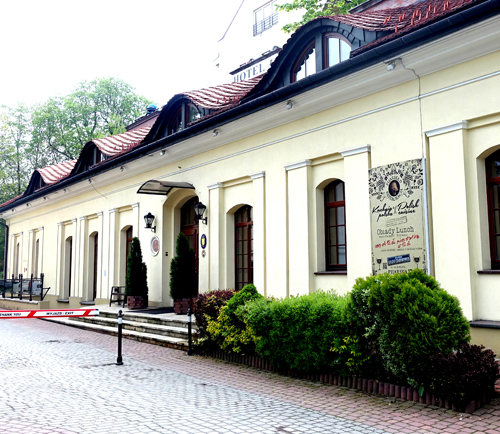
Over the past 8 years Guernsey, where my grandfather was born (and four generations of my family had lived) has become a frequent destination; this trip marks the 8th visit. And we combined this trip with a first trip to Kraków, Poland and stopovers in England.
On May 2nd, we left Hamilton, and slept our way (thanks to Zopiclone) to Gatwick via AirTransat. Connections via EasyJet to Kraków required that we stay overnight; so, we booked a room in Brighton, a half hour train ride from Gatwick airport.
Our first experience with Brighton a few years earlier had amounted to a few hours in the town and we had not been impressed. But we decided to give it a 2nd chance and we were well rewarded. After checking into the Ibis Hotel, a half block away from the train station, we wandered through the Lanes, a collection of narrow alleyways known for their small shops ending up at the sea and the famous Brighton pier.
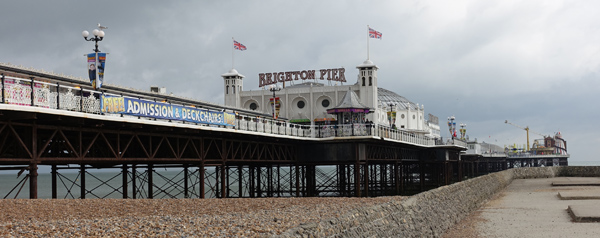 That was followed by an early dinner at Polpo, a great Italian restaurant beside the Theatre Royal.
That was followed by an early dinner at Polpo, a great Italian restaurant beside the Theatre Royal.
Tana had discovered that a play, Fracked!, starring James Bolam, who we knew for his role as John “Jack” Salford in New Tricks, was playing there. Described as a “provocative new comedy about an idyllic English village threatened by an energy company intent on drilling for shale gas,” it boasted an acclaimed, sold-out run at Chichester Festival Theatre. But honestly, for us, jet-lagged and facing an early morning, it seemed amateurish and we slipped out at intermission.
Our EasyJet flight to Kraków demonstrated how this airline has become a culture (or lack of culture) unto itself. It carried, along with the many Brits off to enjoy a cheap holiday, a stag party complete with the groom dressed as a “stewardess." Oh well, he looked good in high heels and in only 2 ½ hours we arrived (and on time).
Hotel Maltański which we had booked for 6 nights, turned out to be a pleasant spot well located right by the lush greenery that surrounds the Old Town .
Krakow, the second largest and one of the oldest cities in Poland, dates back to the 7th century, having a rich history as a centre of Polish academic, cultural, and artistic life. Now a tourist hub, it's a beautiful city which unlike Warsaw, Poznań and Białystok was not razed to the ground during WWII. Hitler had seen Poland as historically German and had especially liked the buildings and architecture there. So an effort had been made to turn Krakow into a German city that one day (after the Jews were removed and streets and locations had been given German names) would be the Capitol of Southern Germany.

Old Town and the Main Market
Like many ancient European cities and towns, Karkow was built around a large centre market square and remains intact as the vibrant centre of today's Old Town. So, it was the first place we headed to get out bearings and plan the next few days reminiscent of the one in Prague. Except for St. Mary's Basilica (also known as the Church of Our Lady Assumed into Heaven) in one corner, restaurants now line the square in what were once townhouses of prominent citizens. Every hour on the hour a trumpeter signals from the top of the taller of the church’s two towers. The plaintive tune breaks off in mid-stream to commemorate the trumpeter who was shot in the throat while sounding the alarm before the Mongol attack on the city in the 13th century.
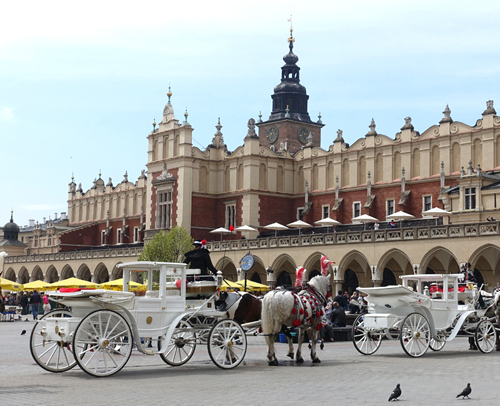 In the middle of the square is the Cloth Hall with its exotic façade. Once the place to go for imports from the east – spices, silk, leather - in earlier times, now it has been taken over by shops selling Polish goods and the ever popular souvenirs.
In the middle of the square is the Cloth Hall with its exotic façade. Once the place to go for imports from the east – spices, silk, leather - in earlier times, now it has been taken over by shops selling Polish goods and the ever popular souvenirs.
On that first stroll through, I found a store selling Polish-made pipes made from pear root (rather than briar) and over the next few days I purchased 3 interesting ones to add to my collection.
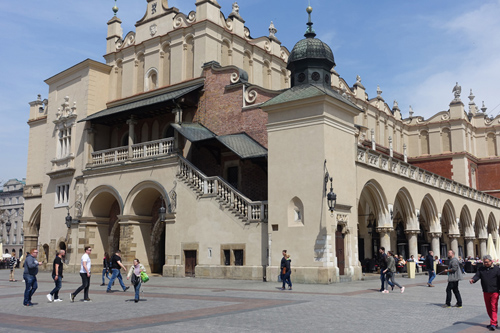
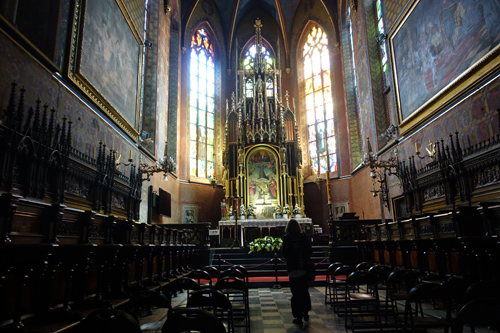
---

One block away from the hotel, ramps led up a hill to Wawel Castle, the Renaissance palace and royal residence of the kings of Poland. While the outside architecture is impressive, described as the crown jewel of Kraków's architectural treasures, the interior, now a museum, struck us as poorly planned giving little sense of Poland's history of occupation and plundering through the centuries.
WWII was far from the first war that left a mark on the present day Krakow but it is the history of that war which now draws many tourists to the ciy. You can’t be in Krakow without thinking about WWII.
Auschwitz and Birkenau
An hour’s drive outside of Krakow is this infamous concentration camp, the largest of German Nazi camps and extermination centers. Over 1.1 million men, women and children both Jewish and non-Jewish were killed there as part of the Nazi Final Solution to the Jewish Question. 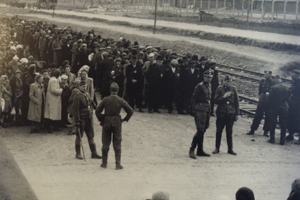 From early in 1942 until late in 1944, transport trains had delivered Jews to the camp's gas chambers from all over German-occupied Europe, where they were killed en masse with the pesticide, Zyklon B.
From early in 1942 until late in 1944, transport trains had delivered Jews to the camp's gas chambers from all over German-occupied Europe, where they were killed en masse with the pesticide, Zyklon B.
Auschwitz has been carefully preserved as a reminder of the atrocities committed and a memorial to the 1.3 million who were sent to the camp, of whom 85% were killed. When we had told friends that we were going to Krakow, many had stressed the importance of visiting there and we were prepared for a disturbing experience. But for us it didn't have the expected shock effect.
There was no sense of the prisoners or their captor; no sense of the life they lived there; of the horror they experienced. The buildings were empty (quite naturally,) the grounds were neat and cared for, the air was clean and quiet. We left with the sense that the books we were reading imparted more of the feeling – horrible, graphic but real – to the place.

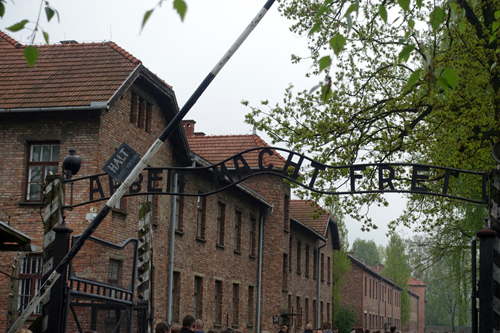

Krakow had its own concentration/extermination camp - Płaszów. I was interested in seeing it having read a book: My Grandfather Would Have Killed Me written by Jennifer Teege. She had discovered the "family secret" that her grandfather had been the infamously cruel Amon Göth, the SS commandant who was sadistic in his treatment and killing of prisoners. For example, he was known to interrupt his breakfast, pick up a rifle and go to a window from which he would randomly shoot and kill a few prisoners before returning to his meal.
When we asked a guide about it, he said that there was nothing to see other than a monument. While the Commandant's house still stands, it is privately owned, not a tourist site. But I regret not having walked by that house and through those grounds because this place was hauntingly clear from my reading..
At the same time, Tana had been reading another book entitled The Pages In Between, written by Erin Einhorn, an American Jewish woman who had moved to Kraków in search of her own family history. In doing so, she had come to know the Polish family who had hidden her grandmother. This book gave glimpses into the negative way most Poles saw the Jews during the war and the fascination of some younger Poles today with Jewish religion, culture and history.
Jewish Ghetto and Schindler’s List
On our first night in Krakow, we found our way to a restaurant in Kazimierz; a lively area of outdoor cafes that feature mostly unremarkable, non-authentic kosher food and plenty of live music. It had once been the Jewish Quarter: old/ancient synagogues are still there. After the war, this area stood, mostly deserted, forgotten and in decay for decades. When the 1993 movie "Schindler's List" became a hit and then won the Academy, it was transformed into the tourist magnet it is today.
Late the next afternoon, we gathered at the Old Synagogue in Kazimierz, the oldest synagogue building still standing in Poland, and one of the most precious landmarks of Jewish architecture in Europe for a Free Walking Tour. Led by a guide native to Kraków, we began to grasp what it had been - and what had happened there. Before the war, there had been about 70,000 Jews in Krakow, with about 20,000 Jews living in the Jewish Quarter attended those synagogues and eaten genuine Kosher food. Now there are only a few hundred Jews in all of Kraków. Many had fled before the German army marched in, many more were shipped out to camps and vast numbers were killed right there in the Ghetto. About 10,000 returned after the war but the unwelcoming reality of Krakow under Soviet rule led to the emigration of the majority of these Nazi-era survivors.
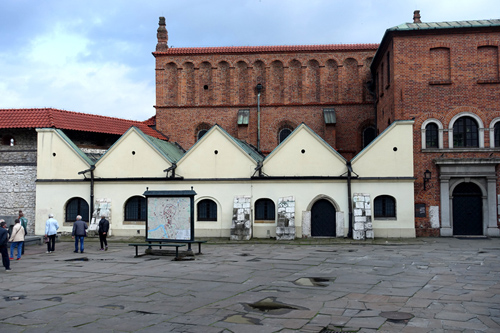 After roaming the old quarters, we crossed the River Wisla into the area that had been walled off in the early stages of WWII to become "the Ghetto." All Jews in the city were forcibly relocated to this area, most to be later transported to a concentration or extermination camp like Płaszów or Aushwitz or killed right there in the ghetto’s square. It was on June 4, 1942 that the first "selection" took place there and at least 111 people were shot in the square or in allies nearby. The bodies were then carted away to be buried in a collective grave in the grounds of the Płaszów camp and their property, which had been thrown out windows into the square, was removed/stolen. Empty chairs now stand in the square as a disturbing reminder and memorial.
After roaming the old quarters, we crossed the River Wisla into the area that had been walled off in the early stages of WWII to become "the Ghetto." All Jews in the city were forcibly relocated to this area, most to be later transported to a concentration or extermination camp like Płaszów or Aushwitz or killed right there in the ghetto’s square. It was on June 4, 1942 that the first "selection" took place there and at least 111 people were shot in the square or in allies nearby. The bodies were then carted away to be buried in a collective grave in the grounds of the Płaszów camp and their property, which had been thrown out windows into the square, was removed/stolen. Empty chairs now stand in the square as a disturbing reminder and memorial.
Much is known of what happened in the Ghetto on a day-to-day basis, from the start to the end of the War, because of the records kept by the one non-Jewish inhabitant who managed to stay inside the Ghetto. He was a Polish Catholic druggist named Tadeusz Pankiewicz. Refusing to leave, he'd managed to receive a license to continue to run his pharmacy overlooking the square at Small Rynek 20 (now number 18). His book, “The Cracow Ghetto Pharmacy”, written after the war, based on his diaries and his vivid memories, portrays starkly and humanly what life was like in the Ghetto , with death on almost every page. Tana found one copy of this (decidedly non-touristy book) in a local bookstore and brought it home as her one souvenir of our visit to Kraków.
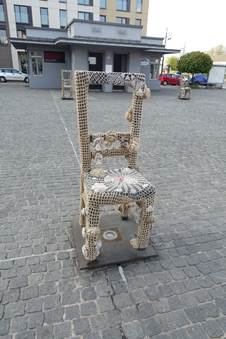
A final stop on our tour took us through winding streets all the way to the front gate of Oskar Schindler's Factory of Enameled Vessels, a large building that's now a museum. Standing outside the front gate, our guide spoke about Schindler - how different (and more complex) the real life story was from the film version.
We returned to the same cafe we'd eaten at earlier, not because the good was great but because we were in the area, our feet were tired and we were hungry. It was again a warm, pleasant evening and it was interesting to be sitting there again, seeing things with greater awareness of the past.
More about the Nazi Occupation and the Soviet era
On our final afternoon in Krakow, we joined a walking tour led by a terrific guide, Ania. Beginning at Katyn Cross near Wawel Castle, and wandering through the centre of Krakow, she told stories of life during the Nazi and Communist occupations - of acts of heroism and of betrayal. And she concluded the tour at the Gestapo Headquarters just outside of the Old Town. After being liberated from the Nazis, Krakow had immediately been occupied by the Soviet army and the Gestapo Headquarters had become the KGB headquarters. Reminders of which were evident in the sadly deteriorated facades of the buildings.

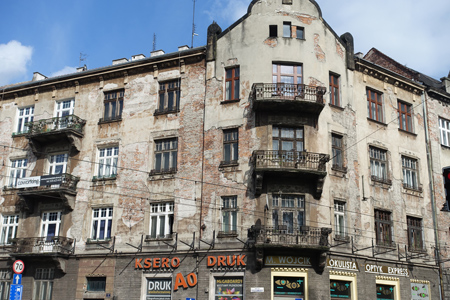
Wielicka Salt Mine
Having had enough of the war, we signed up for a tour of the salt mines in Wielicka a half hour ride outside of the city. It is often referred to as "the Underground Salt Cathedral of Poland" Since the 13th century, the mine, one of the world's oldest salt mines, produced table salt continuously until 2007. More than 500 wooden steps carried us down 327 meters from the mine surface to a labyrinth of tunnels stretching over 287 kilometres (178 mi) in all directions and alcoves with dozens of statues and four chapels that had been carved out of the rock salt by the miners over centuries.
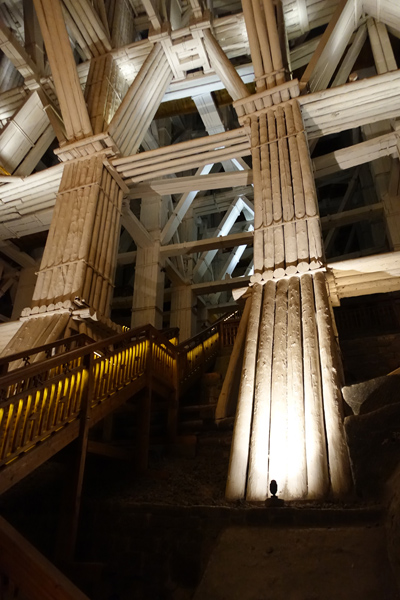

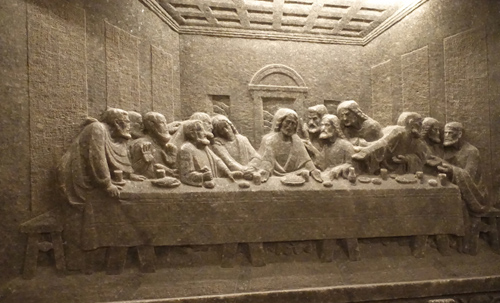
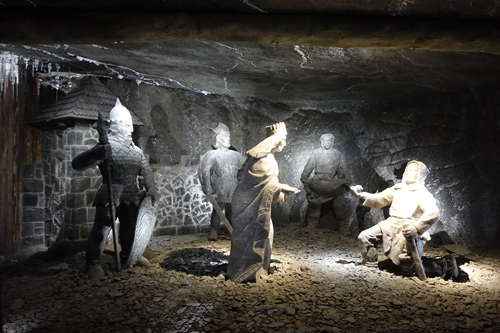
 The rock salt is naturally grey in various shades, resembling unpolished granite but becomes bright with tones of yellow in the light.
The rock salt is naturally grey in various shades, resembling unpolished granite but becomes bright with tones of yellow in the light.
(A point of curiosity: After returning home, we took a n overnight trip to southwest Ontario stopping in Goderich, where we discovered that the largest underground salt mine in the world is in Canada. Located 1,800 feet under Lake Huron, it's as deep as the CN Tower in Toronto is tall. The plant has operated since 1867, after an unsuccessful search for oil uncovered a vast bed of rock salt under Goderich and now produces the Sifto salt that's in our kitchen (and much of the salt used on N. American roads to deal with icy conditions in winter.)
We can’t leave Poland without a comment about “Polish Cuisine” as the restaurants advertise. The first evening in Krakow, Tana eagerly ordered perogies, a national dish. When it arrived there were easily a dozen golden brown packets, far more than most people would want, but no sour cream or needed condiment. As it turned out, every restaurant promoted the same menu and beef, pork and chicken.
We ordered a bottle of Polish wine that night - and never again; even the waiter had made an attempt to warn us. And after that bottle, we stuck pretty much to beer. There are some good polish beers - which a couple of times we stopped to enjoy at a pub call the Bierhalle conveniently located just off the old town square. Another food that we discovered is really great is the chocolate ice cream; they produce excellent chocolate in Poland and that ice cream was great. Unfortunately, the weather was much of the time too cool for ice cream cones.
Near the end of our stay we did find a couple of quite good restaurants not listed in our tourist guide. Both were on nearby Poselska Street - a short walk from the hotel. The first one we tried was an Italian one called Corleone and, on our final night, went to The Black Duck - a lovely restaurant serving polish food we both enjoyed.
We departed next morning, having enjoyed our "taste" of Poland and looking forward to our time in Guernsey with its appealing European cuisine - and great wines.
Guernsey is Guernsey
Each time we go we wonder whether the charm will wear off - it never does. Once again we enjoyed the walking, eating and visiting. As has become our custom, we stayed first at St George’s in town and then at La Barbarie in St Martins.
We had scheduled this visit to coincide with the Guernsey Literary Festival largely because that provided an opportunity to meet up again with Steve Foote who was involved in organizing the Festival. Our expectations of the Festival itself had not been high but we were proven wrong; each of the four events we'd signed up to attend turned out to be of extremely high calibre - engaging & thought provoking:
● MARIE AND JEAN BAPTISTE HUGO (descendants of Victor Hugo) did an evening presentation in Hugo’s Hauteville House (where the author had lived while writing Les Miserables), each of them focusing on their memories, connections with the house and what especially interested (and inspired) them about it. (It's a fascinating place - often thought to be like a poem illustrating the movement (from the ground floor upward) from darkness into light.)
● DAVID BELLOS, Professor at Princeton and acknowledged authority on Hugo, spoke about his newly released book Les Misérables: The Novel of the Century.
● SARAH MOSS, novelist and professor at Warwick University who writes while "thinking like a detective", addressed provocatively the issue of Historical Fiction or Fictional History.
● DUNCAN BARRETT and NUALA CALVI, a couple who jointly authored a trio of Sunday Times top 10 best sellers (starting with The Sugar Girls) talked about how they write books together - and the process whereby they craft true-life stories.

We met up on our first day there with Steve Foote and his author colleague Edward Chaney at a recently opened restaurant: Slaughterhouse Bar and Eatery. It's in what was the old slaughterhouse at the Castle pier; meat hooks hang from the ceiling as a reminder of what it used to be. And, while that can be a bit disturbing (especially for a vegetarian like Tana), it's an historically interesting spot - with a menu that, as well as meat, has good vegetarian items. (I actually went for the fish & chips.) We crossed paths with both of them again several times .
We went to several of our favourite restaurants - with La Nautique remaining at the top of our list along with the dining room at The Barbarie (where we ended up eating dinner twice) and meeting up with Tony for lunch. On our final day, while strolling back to our hotel via La Bellieuse Farm, Tony was sitting out front with his lady friend and invited us to join them on the lawn for a coffee.
LONDON
A pleasant couple of days in one of our favourite cities; it's a toss-up between London & Rome.
We went to onenuaical - An American in Paris - it was great! We were especially impressed by the staging and effects and the speed at which everything (including the mood) could be changed literally before our eyes. Before the show we had an excellent dinner at an Italian Restaurant called La Pastaia well worth going back to. Tana had wanted to see Harry Potter and the Cursed Child but it wasn't playing the 2 nights we were there. We passed by the theatre where it is playing and saw the great magical facade that's been constructed at the entrance - likely we'll make a quick trip to London in the Fall to see that play - a good excuse to fly to London.
| Back to Travel Index | Back to Home |
78 Mountain Ave, Hamilton, Ontario, Canada L8P4G2
|
|
